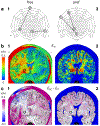Prospects for transcranial temporal interference stimulation in humans: A computational study
- PMID: 31473351
- PMCID: PMC6819277
- DOI: 10.1016/j.neuroimage.2019.116124
Prospects for transcranial temporal interference stimulation in humans: A computational study
Abstract
Transcranial alternating current stimulation (tACS) is a noninvasive method used to modulate activity of superficial brain regions. Deeper and more steerable stimulation could potentially be achieved using transcranial temporal interference stimulation (tTIS): two high-frequency alternating fields interact to produce a wave with an envelope frequency in the range thought to modulate neural activity. Promising initial results have been reported for experiments with mice. In this study we aim to better understand the electric fields produced with tTIS and examine its prospects in humans through simulations with murine and human head models. A murine head finite element model was used to simulate previously published experiments of tTIS in mice. With a total current of 0.776 mA, tTIS electric field strengths up to 383 V/m were reached in the modeled mouse brain, affirming experimental results indicating that suprathreshold stimulation is possible in mice. Using a detailed anisotropic human head model, tTIS was simulated with systematically varied electrode configurations and input currents to investigate how these parameters influence the electric fields. An exhaustive search with 88 electrode locations covering the entire head (146M current patterns) was employed to optimize tTIS for target field strength and focality. In all analyses, we investigated maximal effects and effects along the predominant orientation of local neurons. Our results showed that it was possible to steer the peak tTIS field by manipulating the relative strength of the two input fields. Deep brain areas received field strengths similar to conventional tACS, but with less stimulation in superficial areas. Maximum field strengths in the human model were much lower than in the murine model, too low to expect direct stimulation effects. While field strengths from tACS were slightly higher, our results suggest that tTIS is capable of producing more focal fields and allows for better steerability. Finally, we present optimal four-electrode current patterns to maximize tTIS in regions of the pallidum (0.37 V/m), hippocampus (0.24 V/m) and motor cortex (0.57 V/m).
Keywords: Bioelectricity simulation; Finite element modeling (FEM); Non-invasive brain stimulation; Optimization; Temporal interference; Transcranial alternating current stimulation (tACS).
Copyright © 2019 Elsevier Inc. All rights reserved.
Figures











Similar articles
-
[Quantitative analysis of transcranial temporal interference stimulation in rodents: A simulation study on electrode configurations].Sheng Wu Yi Xue Gong Cheng Xue Za Zhi. 2025 Apr 25;42(2):280-287. doi: 10.7507/1001-5515.202411054. Sheng Wu Yi Xue Gong Cheng Xue Za Zhi. 2025. PMID: 40288969 Free PMC article. Chinese.
-
Interindividual variability of electric fields during transcranial temporal interference stimulation (tTIS).Sci Rep. 2021 Oct 13;11(1):20357. doi: 10.1038/s41598-021-99749-0. Sci Rep. 2021. PMID: 34645895 Free PMC article. Clinical Trial.
-
Multi-objective optimization via evolutionary algorithm (MOVEA) for high-definition transcranial electrical stimulation of the human brain.Neuroimage. 2023 Oct 15;280:120331. doi: 10.1016/j.neuroimage.2023.120331. Epub 2023 Aug 19. Neuroimage. 2023. PMID: 37604295
-
Can transcranial electric stimulation with multiple electrodes reach deep targets?Brain Stimul. 2019 Jan-Feb;12(1):30-40. doi: 10.1016/j.brs.2018.09.010. Epub 2018 Sep 26. Brain Stimul. 2019. PMID: 30297323 Free PMC article. Review.
-
Current challenges: the ups and downs of tACS.Exp Brain Res. 2019 Dec;237(12):3071-3088. doi: 10.1007/s00221-019-05666-0. Epub 2019 Oct 16. Exp Brain Res. 2019. PMID: 31620829 Review.
Cited by
-
Magnetically Induced Temporal Interference for Focal and Deep-Brain Stimulation.Front Hum Neurosci. 2021 Sep 27;15:693207. doi: 10.3389/fnhum.2021.693207. eCollection 2021. Front Hum Neurosci. 2021. PMID: 34646125 Free PMC article.
-
A mini-review: recent advancements in temporal interference stimulation in modulating brain function and behavior.Front Hum Neurosci. 2023 Sep 14;17:1266753. doi: 10.3389/fnhum.2023.1266753. eCollection 2023. Front Hum Neurosci. 2023. PMID: 37780965 Free PMC article. Review.
-
Effects of transcranial direct current stimulation on motor skills learning in healthy adults through the activation of different brain regions: A systematic review.Front Hum Neurosci. 2022 Oct 6;16:1021375. doi: 10.3389/fnhum.2022.1021375. eCollection 2022. Front Hum Neurosci. 2022. PMID: 36277051 Free PMC article.
-
Toward integrative approaches to study the causal role of neural oscillations via transcranial electrical stimulation.Nat Commun. 2021 Apr 14;12(1):2243. doi: 10.1038/s41467-021-22468-7. Nat Commun. 2021. PMID: 33854049 Free PMC article. Review.
-
Comparing the effects of transcranial alternating current and temporal interference (tTIS) electric stimulation through whole-brain mapping of c-Fos immunoreactivity.Front Neuroanat. 2023 Mar 13;17:1128193. doi: 10.3389/fnana.2023.1128193. eCollection 2023. Front Neuroanat. 2023. PMID: 36992795 Free PMC article.
References
Publication types
MeSH terms
Grants and funding
LinkOut - more resources
Full Text Sources
Other Literature Sources

